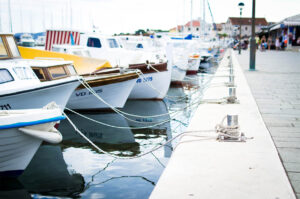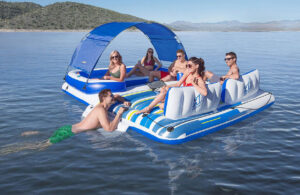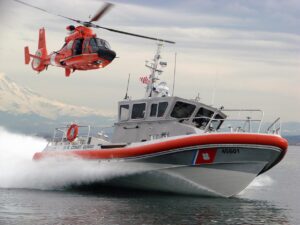Captain’s Tips – Risk is part of life. Anything that adds adventure to our lives adds risk, but seeking unbridled escapades doesn’t have to mean accepting unlimited risk. Boating is one of the most rewarding adventures, and fortunately is one in which related risks can be easily managed.
Knowing the most likely cause of boating accidents is the first step in preventing them. Awareness will manifest itself in prevention first. According to data from the U. S. Coast Guard, the top five primary contributing factors in boating mishaps are inattention, improper lookout, operator inexperience, machinery failure and alcohol use. With a little forethought and planning, you can manage each of these known risks to keep boating a safe adventure for you and your family.
Although few of the accidents are reported, strong anecdotal evidence indicates that more personal injury accidents happen while a boat is still tied in the slip or anchored than occur while underway. Just the simple act of boarding a boat can be risky.
Gaps between the pier and boat, poorly placed or no hand holds, having to
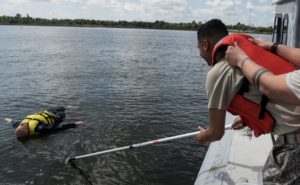
step up or down, boarding while carrying bags, and slippery surfaces, all combine to turn what is usually a simple event into a dangerous process. Add any level of distraction, and it’s an accident waiting to happen. All these conditions and worse can apply to boarding a moored or anchored boat from a tender as well.
We recently met a family whose boat was tied across a pier from us at a marina. They were preparing their catamaran for a world circumnavigation. The grandparents were highly experienced sailors who had already circumnavigated once. This time their children and grandchildren were joining them. Shortly after we arrived at the marina and had the opportunity to watch them board their boat a few times, my wife said to me, “It sure looks dangerous how they board their boat by stepping on the spring line.” Just days after that, the grandfather fell while stepping off the boat and broke his hip.
Or take the case of our friend who was distracted while talking on her phone and stepped into the gap between the boat and the pier. From her position in the water, both the pier and boat’s side were so high that she couldn’t pull herself out. Fortunately, her husband heard her fall and rescued her. Both incidents could have been prevented by assessing the risk involved in boarding the sailboat, and in the second example by eliminating distractions when stepping off the boat.
Boating takes place in an environment that is dynamic in its risk potential. The inherent risks associated with any activity on the water requires a more continuous level of attention than sports where risk management is focused exclusively on minimization. Boater can only do so much to minimize risk in an activity with constantly changing factors, many of which are out of your control. Consequently, having plans in place to react to risks or dangers are as important as the steps taken to minimize the risks.
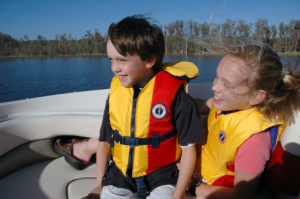
Safety aboard the boat is more than just having the latest safety equipment, it is a state of mind, a willingness to say, “What if?” and an unwillingness to become a statistic. When most boaters free their lines and head for open water, they do so in a mild state of denial, an innocent but dangerous unwillingness to admit something could go wrong aboard the boat. They are understandably but also unfortunately more focused on the day’s adventure.
Boating is a wonderful experience, and anything that adds adventure to our lives adds risk. Evaluating the potential risks in boating every time you set sail will go a long way toward keeping you, your family and friends safe while boating.
“Safety aboard the boat …
is a state of mind,
a willingness to say,
“What if?””
Step-by-Step Process
The process of reducing risks in boating is like those described above for boarding — identify the hazard and take steps to reduce or eliminate the condition. This is best done in a step-by-step process with a checklist each time you prepare the boat for an outing. The following list is a good starting point, and you can add to this list items specific to your boat and individual condition.
Inspect all railings and lifelines. Neatly stow all dock lines and fenders, so you don’t create trip hazards. Consider placing additional handholds or railings around the deck for safe movement, especially in areas that transition up or down. Ensure all decks and stair treads are slip resistant.
Do you know how you would help someone back on board if they fell in the water? Are throwable flotation devices conveniently placed around the boat?
Are handholds strategically placed to always have one within reach? Secure all loose objects, especially anything overhead that could fall when the boat is moving.
Be certain everything needed for safe operation is at the helm and within reach. Leaving the helm, even if only for a second to get an item like binoculars, can cause an accident. Configure the helm arrangement to be comfortable, especially if you could be underway for long periods of time. Stress and fatigue are increased if the helm is not comfortable when underway.
. There’s always something on the boat that needs fixing, but at a minimum make sure everything necessary for safe operation is fully functional.
Do you have the correct fire-fighting equipment on board? Do you have a fully stocked first aid kit and a life jacket for every person onboard?
Going out in weather beyond the boat or captain’s ability to handle it, is just asking for trouble. This includes being flexible with planned outings or departure times. Strict adherence to a schedule in the face of deteriorating conditions has ruined many voyages. With today’s sophisticated weather forecasting, a boater should rarely be caught by surprise with an unexpected storm.



